Bon Appétit! Compared to today, nourishment was only one consideration as King Charles II sat down to his dinner table. When dining, the king showed himself off in lavishly decorated rooms surrounded by magnificently painted ceilings, kneeling servants and exquisite delicacies. What truly occurred at these glamourous meals? And how was the court hierarchy reflected by the arrangement of the dining room?

The custom of royals dining in public was not introduced under Charles II; the ceremonies at the court of his father, King Charles I, were the strictest in all of Europe in the 1630s. For instance, he preferred his servants to bring him his food while kneeling, a custom that his son, Charles II, later reestablished.
“[The spectators should] stay towards the lower end of the chamber, & shall not presse too neare the table whereby the rome may be pestered, & our service hindered.”
(TNA, LC5/180 fol. 10v, cf. BL, Stowe MS 562, fol. 5v)
This painting was made in Charles II’s childhood, not during his reign. The Prince of Wales, just five years of age, is seen dining together with his parents, King Charles I and Queen Henrietta Maria. Numerous servants wait on the royals while an audience watches the proceedings.
The spectators of the dining ceremony were kept at a respectable distance during the reign of Charles I. His son followed this tradition and went so far as to introduce a balustrade as a physical barrier. The audience was permitted into the dining room as long as its members were of so-called ‘good Quality’ and wore the correct attire. This vague wording permitted people from social classes outside of the nobility and the clergy to attend. Consequently, more people were allowed to come and observe these events during the reign of Charles II.
– Y. Tj.
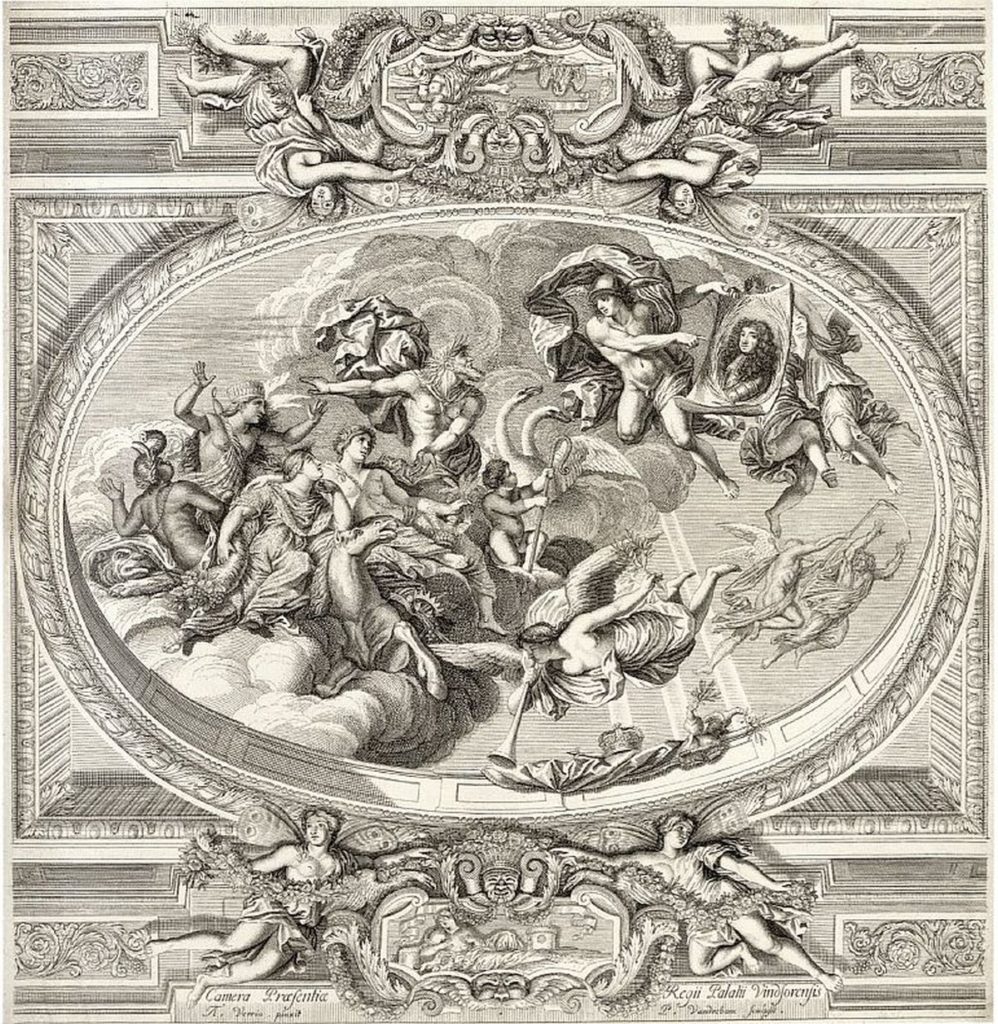
At least once a week King Charles II dined before an audience in the King’s Presence Chamber. Unlike dinner (the midday meal), breakfast and supper (the evening meal) were solely taken privately.
Antonio Verrio made around twenty ceiling paintings for Windsor Castle. These included the painting in the King’s Presence Chamber. Peter Vandrebranc’s engraving shows the central scene and provides an idea of how the destroyed picture may have looked. The painting creates an illusion and an extension of the room’s architecture. It gives the visitor a view of the painted sky.
The engraving shows Mercury on the top right. He presents the king’s portrait to the four continents. The personification of Europe is situated on the front left of the picture and holds a cornucopia. Asia has her arm draped over Europe’s shoulders. Behind them sits Africa, who can be distinguished by the elephant’s trunk on her head. The personification of America wears a feathered headdress and raises her hands in astonishment in the background. All four of them look up to the king’s portrait in awe.
Verrio’s painting suggests that the whole world looked on the king with admiration. To some extent it served as a guide for the behaviour of guests at the king’s public dinners; they should also show Charles II appropriate reverence.
– S. Wo.
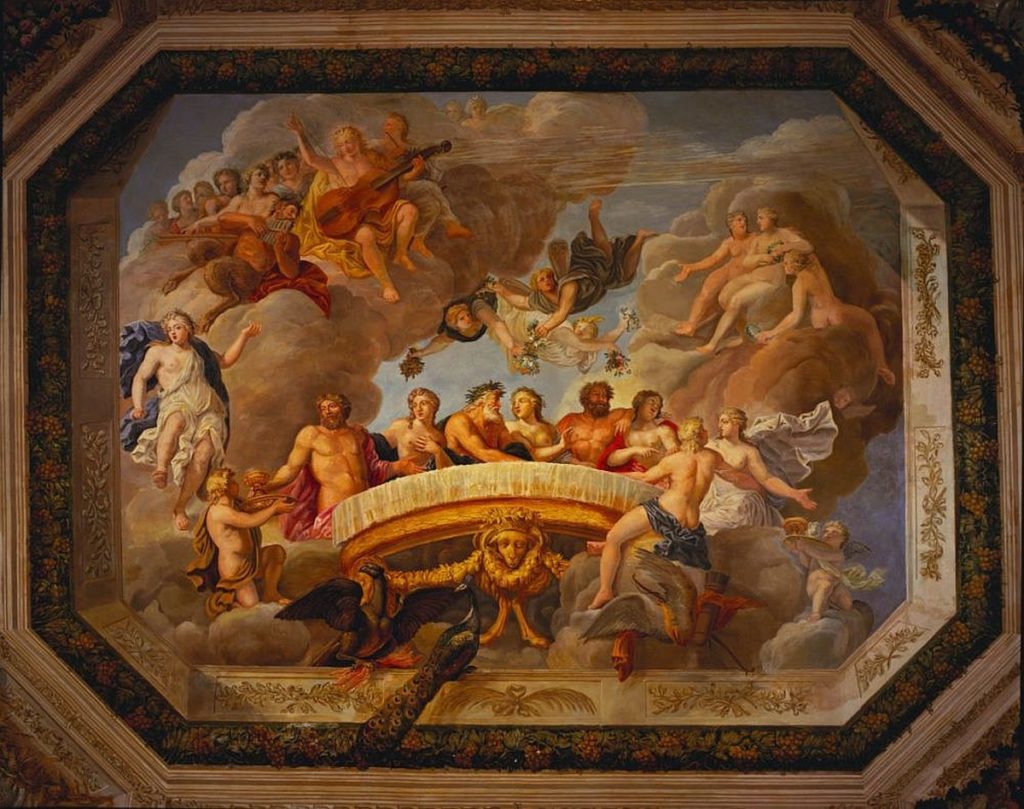
In addition to the King’s Presence Chamber, which was used for public dining, Windsor Castle also had an Eating Room. It was located next to Charles’s II bedroom and served as a private dining room for close family and friends.
Antonio Verrio’s ceiling painting is one of the few original decorations from Charles’s II era that remains in the castle today. It shows the Roman gods celebrating around a splendidly decorated banquet table. An eagle holding a lightning bolt and a peacock are depicted under the table. These are attributes for Jupiter and Juno, who are the rulers of Olympus. They represent the English royal couple.
A crowd of people is gathered on the clouds surrounding the table and observes the festivities in the centre. This references the English concept of public dining. The three graces are depicted on the top right, while the seven muses are on the top left, led by the god Apollo. He is engaged in a music contest with the satyr Marsyas. Marsyas plays the panpipes whereas Apollo has chosen the king’s favourite instrument, the guitar. This shows that musical entertainment was also an important part of the public dining ritual at the royal court.
– S. Wo.
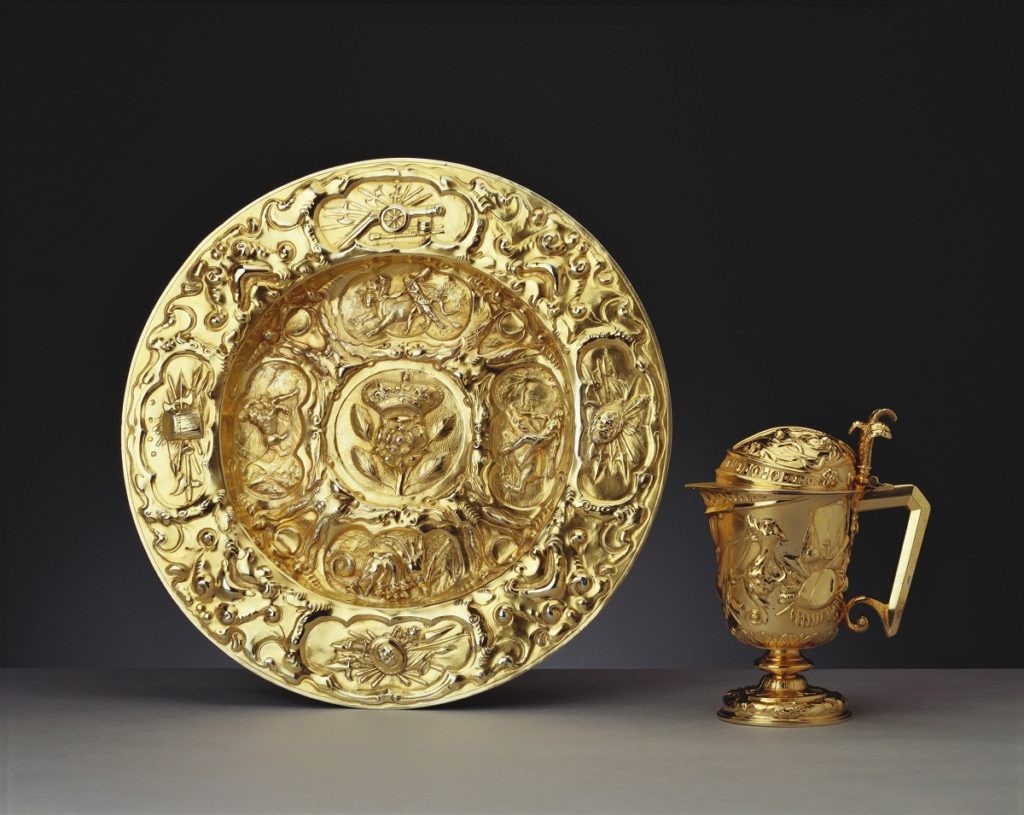
The festivities of public dining ended with a handwashing ceremony. At the royal court this took place with rosewater. The water was poured over the king’s hands from an ewer and into a golden basin.
The highly decorated basin has an English rose with four leaves and a crown in its centre. The middle circle depicts the twelve labours of Hercules. The outer circle of the basin shows among other items a cannon, war trophies and a war drum. These militant and triumphant motifs recall the successful restitution of the monarchy, as the basin was made shortly after Charles returned to England from his exile. The original ewer was lost and replaced in 1690.
The handwashing ritual also formed part of the royal healing. In this, two nobles and the Lord Chamberlain assisted the king in washing his hands. One was responsible for holding the basin, another for pouring the water over the hands of the king and the last had the honour of giving him a towel to dry off. A similar ritual could have taken place after the dining ceremony.
– Y. Tj.
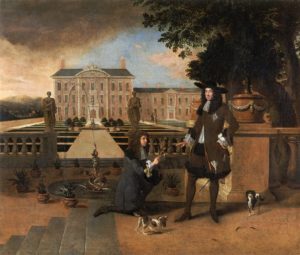
Exotic and imported foods were to be expected at the royal dining table. The pineapple or the ‘King-Pine’, as it was referred to by John Evelyn, was a novelty. Evelyn, who had the opportunity to try the fruit as he was standing next to the king and had it served to him directly from the king’s plate, found his first encounter with the fruit rather disappointing.
“in my opinion it falls short of those ravishing varieties of deliciousness describ’d in Capt. Ligon’s History, and others; but possibly it might, or certainly was, much impair’d in coming so far.”
(John Evelyn, Diary, 19 August 1668)
John Rose has long been considered the first person to grow a pineapple in England. He is portrayed by Danckerts presenting the king with the fruit in front of an unidentified country manor. Charles II is seen wearing rather relaxed clothing, with only the star of the Order of the Garter to show his rank. The painting is dated around 1677, the year in which the king shaved off the beard that he had been wearing since at least 1660. Since John Rose passed away in 1677, the painting could be linked to his death as a commemorative object.
The pineapples seem to be planted outside in pots. The cold English climate however makes it hard to believe that the results of this endeavor were fruitful. Pineapples were first successfully grown in heated greenhouses in the eighteenth century. Even Evelyn described the fruit in his diary as being imported. As such, Danckerts’ painting may be more a result of wishful thinking rather than a truthful depiction.
– Y. Tj.

Charles II and his contemporaries were fascinated by exotic objects and foods. Pieter Gerritsz van Roestraten’s still life painting depicts a table with five porcelain cups, a sugar bowl, and a teapot. The white cups were decorated with a blue Chinese pattern.
Charles’s marriage with Catherine of Braganza of Portugal opened the way to Asia for England. The queen not only brought her enthusiasm for Asian decorations and jars, but also introduced the English court to the ritual of tea drinking. Owning and consuming those luxury items was seen as a sign of wealth. Tea, which originated from China, became an especially popular beverage in England. Due to high demand, tea production was introduced to India, which facilitated the trade.
– S. Wo.
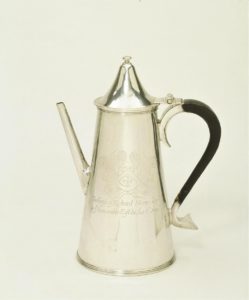
Some of the foods that are an established part of British consumer goods today were first introduced during the reign of Charles II. Tea competed against another equally exciting new product, coffee. The popularity of coffee rose during 1665 und 1666, the years in which the Ottoman ambassadors marketed the drink during extravagant soirées. The rise of the coffeehouses as places of political debates even led to a temporary ban on the institutions by the king.
“Whereas it is most apparent, that the Multitude of Coffee-Houses of late years set up and kept within this Kingdom […] have produced very evil and dangerous effects; as well for that many Tradesmen and others, do therein mis-spend much of their time […] but also, for that in such Houses, and by occasion of the meetings of such persons therein, diverse False, Malitious and Scandalous Reports are devised and spread abroad […]; His Majesty hath thought it fit and necessary, That the said Coffee-houses be (for the future) Put down and Suppressed”
(Charles II, A Proclamation for the Suppression of Coffee-Houses, London 1675)
This coffeepot from the 1680s was made in the Turkish style. The goldsmith and silversmith George Garthorne’s initials “GG” are engraved on the pot. Another inscription reads ‘The Guift of Richard Sterne Eq. to ye Honorable East India Comp.’ This Richard Sterne could well be the Member of Parliament from Yorkshire who owned many shares in the East India Company.
– Y. Tj.
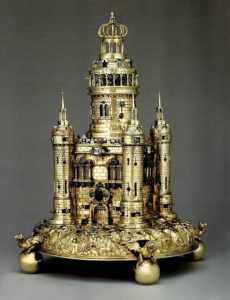
The Salt of State was only brought out on special occasions; for example, it was used during coronation banquets. Otherwise, it was locked away in the Tower of London, where guests could admire it together with the British crown jewels.
This object, which is made of silver gilt and enamel, was made by the Hamburg goldsmith Johann Hass in 1630. The Salt of State was a spice box. Its form is that of a fortress on a square base, surrounded by a hilly landscape. It is adorned with numerous different gemstones.
The Salt of State had been purchased in 1657 as a reconciliation gift for the Russian tsar Alexei Mikhailovich, but the British ambassador failed to deliver it. The goldsmith Robert Vyner presented this extraordinary work of art to the town of Exeter, which in turn offered it to Charles II in honour of his accession in 1660.
– S. Wo.